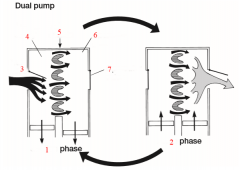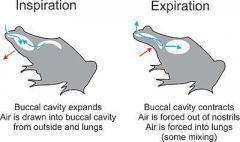![]()
![]()
![]()
Use LEFT and RIGHT arrow keys to navigate between flashcards;
Use UP and DOWN arrow keys to flip the card;
H to show hint;
A reads text to speech;
28 Cards in this Set
- Front
- Back
|
Functions (2) |
Oxygen intake for use by the body removal of waste products of metabolism |
|
|
mechanisms (2) |
Passive diffusion -simplest form Oxygen diffusion -usually high partial pressure in the environment; requiring ATP |
|
|
How does passive diffusion depend on partial pressure? |
movement occurs from higher to lower pressure |
|
|
product of oxygen in respiration |
carbon dioxide |
|
|
Passive diffusion rate factors (4) |
1. surface area 2. distance 3. resistance of barriers to diffusion 4. partial pressure
|
|
|
terminologies (3 binaries) |
external -environment to blood internal -blood to tissue
Ventilation/breathing Perfusion
Unidirectional -fish Bidirectional -many tetrapods
|
|
|
Components: Gills (2 characteristics) |
External respiration for aquatic habitats areas with dense capillaries for respiration |
|
|
Components: Gas bladders -swim bladder (2 functions and 1 example) |
buoyancy control can be used for supplementary respiration squalene (shark's liver oil) |
|
|
Components: Gas bladders -lungs (2 characteristics and their description) |
dead space (alveoli where gas-exchange occurs) tidal volume (total amount of air an organism can hold) |
|
|
Components: Cutaneous respiration (2 characteristics) |
heavy vascularization for areas with thin covering |
|
|
what is device used to measure amount of air an organism can hold? |
Spirometer |
|
|
where can we find cutaneous respiration in reptiles and tortoises?
|
in between scales of reptiles in butts of tortoises |
|
|
Two kinds of gas bladders |
swim bladder lungs |
|
|
Ventilatory mechanisms: Cilia (2 descriptions) |
found in smaller organisms surface area to volume ratio |
|
|
Ventilatory mechanisms: dual pumps in fishes (2 parts) (direction?) |
buccal and opercular pumps unidirectional |
|

Dual Pump Mechanism |
1. Suction Phase 2. Force Phase 3. Oral valve 4. Buccal cavity 5. Gill curtain 6. Opercular cavity 7. Opercular valve |
|
|
Ventilatory mechanisms: Buccal pump (2 categories) |
Two stroke or Four stroke Inspiration and Expiration |
|

What type of buccal pump is this? |
Two stroke |
|

What type of buccal pump is this? |
Four stroke |
|
|
Ventilatory mechanisms: Aspiration pump (found in?) (direction?) (what serves as pumps?) |
amniotes bidirectional ribs and diaphragm |
|
|
Phylogeny: Fish -Chondrichthyans (4 characteristics) |
Countercurrent flow ram ventillation first gill slit -spiracle interbranchial septa |
|
|
Phylogeny: Fish -bony fishes (2 characteristics) note: one character has three functions |
opercular bones gas bladders: respiration, buoyancy control, sound detection and production |
|
|
Phylogeny: Amphibia (describe larval and adult respiration) |
larval: gills adult: cutaneous respiration or lungs |
|
|
Phylogeny: Reptilia (describe lungs and give function of accessory gland) (ventilation mechanism) (snake, crocodiles and turtles) |
Central chamber with faveoli for increasing SA Aspiration pump Snake lungs -usually unpaired, respiratory and saccular portions Crocodiles -liver and lungs Turtles -muscles with carapace, limb movement |
|
|
Phylogeny: Avialae (describe lungs and where is it connected) (how many air sacs and what is its function) (where does air sacs extend) (what is present, what is absent) |
paired lungs connected to trachea 6-12 air sacs that act as bellows extend into bones presence of parabronchi, no blind-ending alveoli |
|

|
1. Trachea 2. Primary bronchus (mesobronchus) 3. Posterior thoracic sac 4. Abdominal sac 5. Lung (parabronchial network) 6. Anterior thoracic sac 7. Interclavicular sac |
|
|
Describe the movement of oxygen in bird respiratory |
CYCLE 1 (a) to posterior thoracic sac, abdominal sac and lungs (inhalation 1) (b) to lungs and trachea (exhalation 1)
CYCLE 2 (c) to posterior thoracic sac, abdominal sac and lungs; to (inhalation 2) (d) to lungs, anterior thoracic sac and interclavicular sacto trachea
|
|
|
Phylogeny: Mammalia (ventilation mechanism) (what is used) |
Aspiration pump (intercostals and diaphragm) Alveoli |

